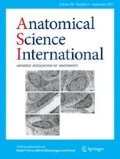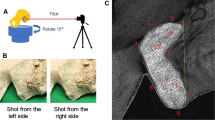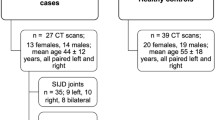Abstract
The purpose of this study was to clarify the relevance of degenerative changes in the sacroiliac joint (SIJ) and the joints in the lower limb and lumbar spine using age estimation methods. We also examined the shape of the auricular surface to determine the effect of degenerative changes on each joint. A total of 200 iliac auricular surfaces from 100 Japanese male skeletons were examined macroscopically in accordance with conventional methods of age estimation. From the obtained estimated age, we calculated the deflection values, which represented the degree of degenerative changes of the joints. For comparison, we used osteophyte score data of the hip, knee, and zygapophyseal joints in lumbar spines from previous studies which had used the same bone specimens. As a quantitative indicator of auricular surface morphology, we defined the constriction ratio (CR) of the auricular surface and compared the CR values obtained with various measured values. Degenerative changes in the SIJ were positively correlated with those in both the hip joint and zygapophyseal joint, but a correlation with knee joints was found only on the left side. In skeletons from individuals aged ≥60 years as time of death, the CR was significantly different between the group with high scores and those with low scores in both the hip and sacroiliac joints. It has been suggested that degenerative changes in SIJs interact with those in the hip joint and zygapophyseal joint. In addition, the shape of the auricular surface may also be a relevant factor for degenerative changes in these joints.








Similar content being viewed by others
References
Abitbol MM (1987a) Evolution of the lumbosacral angle. Am J Phys Anthropol 72:361–372
Abitbol MM (1987b) Evolution of the sacrum in hominoids. Am J Phys Anthropol 74:65–81
Abitbol MM (1988) Evolution of the ischial spine and of the pelvic floor in the Hominoidea. Am J Phys Anthropol 75:53–67
Aiello L, Dean C (1990) Bipedal locomotion and the postcranial skeleton. An introduction to human evolutionary anatomy. Academic Press, London
Beales DJ, O’Sullivan PB, Briffa NK (2009) Motor control patterns during an active straight leg raise in chronic pelvic girdle pain subjects. Spine 34:861–870
Beales DJ, O’Sullivan PB, Briffa NK (2010) The effects of manual pelvic compression on trunk motor control during an active straight leg raise in chronic pelvic girdle pain subjects. Man Ther 15:190–199
Bowen V, Cassidy JD (1981) Macroscopic and microscopic anatomy of the sacroiliac joint from embryonic life to the eighth decade. Spine (Phila Pa 1976) 6:620–628
Buckberry JL, Chamberlain AT (2002) Age estimation from the auricular surface of the ilium: a revised method. Am J Phys Anthropol 119:231–239
Hu H, Meijer OG, van Dieen JH, Hodges PW, Bruijn SM, Strijers RL, Nanayakkara PW, van Royen BJ, Wu W, Xia C (2010) Muscle activity during the active straight leg raise (ASLR), and the effects of a pelvic belt on the ASLR and on treadmill walking. J Biomech 43:532–539
Hungerford B, Gilleard W (2007) The pattern of intrapelvic motion and lumbopelvic muscle recruitment alters in the presence of pelvic girdle pain. In: Vleeming A, Mooney V, Stoeckart R (eds) Movement, stability, and lumbopelvic pain: integration and research. Churchill Livingstone, Edinburgh
Hungerford B, Gilleard W, Hodges P (2003) Evidence of altered lumbopelvic muscle recruitment in the presence of sacroiliac joint pain. Spine (Phila Pa 1976) 28:1593–1600
Igarashi Y, Uesu K, Wakebe T, Kanazawa E (2005) New method for estimation of adult skeletal age at death from the morphology of the auricular surface of the ilium. Am J Phys Anthropol 128(2):324–339
Imamura T, Saiki K, Okamoto K, Maeda M, Matsuo M, Wakebe T, Ogami K, Manabe Y, Koseki H, Tomita M, Tagami A, Osaki M, Shindo H, Tsurumoto T (2014) Characterization of individuals with sacroiliac joint bridging in a skeletal population: analysis of degenerative changes in spinal vertebrae. BioMed Res Int 2014:1–9
Itoi E (1991) Roentgenographic analysis of posture in spinal osteoporosis. Spine 16:750–756
Kapandji IA (1974) The physiology of the joints. Churchill Livingstone, Edinburgh
Lovejoy CO (1988) Evolution of human walking. Sci Am 259:118–125
Lovejoy CO (2007) Evolution of the human lumbopelvic region and its relationship to some clinical deficits of the spine and pelvis. In: Vleeming A, Mooney V, Stoeckart R (eds) Movement, stability and lumbopelvic pain: integration and research. Churchill Livingstone, Edinburgh
Lovejoy CO, Richard SM, Thomas RP, Robert PM (1985) Chronological metamorphosis of the auricular surface of the ilium: a new method for the determination of adult skeletal age at death. Am J Phys Anthropol 68:15–28
Mens JM, Vleeming A, Snijders CJ, Stam HJ, Ginai AZ (1999) The active straight leg raising test and mobility of the pelvic joints. Eur Spine J 8:468–473
Mens JM, Vleeming A, Snijders CJ, Koes BW, Stam HJ (2001) Reliability and validity of the active straight leg raise test in posterior pelvic pain since pregnancy. Spine 26:1167–1171
Mens JM, Vleeming A, Snijders CJ, Koes BW, Stam HJ (2002) Validity of the active straight leg raise test for measuring disease severity in patients with posterior pelvic pain after pregnancy. Spine 27:196–200
Molnar P, Wim B (2007) Osteophytes: relevance and biology. Osteoarthr Cartil 15:237–244
Offierski CM, Macnab I (1983) Hip–spine syndrome. Spine 8:316–321
Redmond MJ, Gupta A, Nasser R, Domb GB (2015) The hip-spine connection: understanding its importance in the treatment of hip pathology. Orthopedics 38(1):49–55
Sashin D (1930) A critical analysis of the anatomy and the pathological changes of the sacro-iliac joints. J Bone Joint Surg 28:891–910
Sato K, Itoi E, Kasama F (1989) Abnormal posture associated with osteoporosis. J Musculoskeletal System 2:1451–1462
Shibata Y, Shirai Y, Miyamoto M (2002) The aging process in the sacroiliac joint: helical computed tomography analysis. J Orthop Sci 7(1):12–18
Stupar M, Côté P, Hawker GA (2010) The association between low back pain and osteoarthritis of the hip and knee: a population-based cohort study. J Manip Physiol Ther 33(5):349–354
Tsurumoto T, Saiki K, Okamoto K, Imamura T, Maeda J, Manabe Y, Wakebe T (2013) Periarticular osteophytes as an appendicular joint stress marker (JSM): analysis in a contemporary Japanese skeletal collection. PLoS ONE 8(2):e57049
Vleeming A (1990) The sacroiliac joint: a clinical anatomical biomechanical and radiological study. Thesis. Erasmus University Rotterdam, Rotterdam
Vleeming A, Stoeckart R, Volkers AC, Snijders CJ (1990a) Relation between form and function in the sacroiliac joint. Part I: clinical anatomical aspects. Spine (Phila Pa 1976) 15:130–132
Vleeming A, Volkers AC, Snijders CJ, Stoeckart R (1990b) Relation between form and function in the sacroiliac joint. Part II: biomechanical aspects. Spine (Phila Pa 1976) 15:133–136
Vleeming A, Schuenke MD, Masi AT, Danneels L, Willard FH (2012) The sacroiliac joint: an overview of its anatomy, function and potential clinical implications. J Anat 221(6):537–567
Yoshimoto H, Sato S, Masuda T, Kanno T, Shundo M, Hyakumachi T, Yanagibashi Y (2005) Spinopelvic alignment in patients with osteoarthrosis of the hip: a radiographic comparison to patients with low back pain. Spine 30:1650–1657
Acknowledgments
The authors would like to remember the donors and thank their families. Without their selfless contribution, this study would not have been possible.
Author information
Authors and Affiliations
Corresponding author
Ethics declarations
Conflict of interest
The authors declare that they have no conflict of interest.
Rights and permissions
About this article
Cite this article
Nishi, K., Saiki, K., Imamura, T. et al. Degenerative changes of the sacroiliac auricular joint surface—validation of influential factors. Anat Sci Int 92, 530–538 (2017). https://doi.org/10.1007/s12565-016-0354-x
Received:
Accepted:
Published:
Issue Date:
DOI: https://doi.org/10.1007/s12565-016-0354-x




